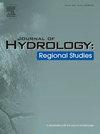Understanding flood dynamics in the Indus River Basin: Lessons from the 2022 Pakistan deluge
IF 4.7
2区 地球科学
Q1 WATER RESOURCES
引用次数: 0
Abstract
Study region
The study focuses on the Indus River Basin and southern Pakistan, severely affected by flooding in 2022.
Study focus
This study assessed how land surface temperature, snow cover, soil moisture, and precipitation contributed to the deluge of 2022. This study mainly investigated MODIS-AIRS land surface temperature, MODIS snow cover (NDSI), SMAP soil moisture, and GPM IMERG precipitation accumulation. Furthermore, different flood visualization and mapping techniques were applied to delineate the flood extent map using Landsat 8–9, Sentinel-2 MSI, and Sentinel-1 SAR data.
New hydrological insights for the region
The region experienced some of the most anomalous climatic events in 2022, such as prolonged heatwaves as observed with higher-than-average land surface temperatures and subsequent rapid decline in snow cover extent during the spring, increased soil moisture followed by an abnormal amount of extreme monsoon precipitation in the summer. The upper subbasins experienced more than 8℃ in positive temperature anomaly, indicating a warmer climate in spring. Subsequently, the snow cover declined by more than 25 % in the upper subbasins. Further, higher surface soil moisture values (> 0.3 m3/m3) were observed in the basin during the spring due to the rapid snow and ice melt. Furthermore, the basin received more than 200 mm of rainfall compared to the long-term average rainfall of about 98 mm, translating to about 300 % more rainfall than usual in July and August. The analysis helps understand the spatial and temporal variability within the basin and facilitates the understanding of factors and their intricate connections contributing to flooding.
研究区域本研究重点关注 2022 年受洪水严重影响的印度河流域和巴基斯坦南部地区。研究重点本研究评估了地表温度、积雪覆盖、土壤水分和降水是如何促成 2022 年洪灾的。本研究主要调查了 MODIS-AIRS 陆面温度、MODIS 雪盖(NDSI)、SMAP 土壤水分和 GPM IMERG 降水累积。该地区在 2022 年经历了一些最反常的气候事件,例如,春季地表温度高于平均水平,导致热浪持续时间较长,随后积雪面积迅速减少;夏季土壤水分增加,随后出现了异常的极端季风降水。上游子流域出现了超过 8℃的正温度异常,表明春季气候变暖。随后,上游子流域的积雪面积减少了 25% 以上。此外,由于冰雪迅速融化,该流域春季地表土壤水分值较高 (> 0.3 m3/m3)。此外,该流域的降雨量超过 200 毫米,而长期平均降雨量约为 98 毫米,这意味着 7 月和 8 月的降雨量比平时多出约 300%。该分析有助于了解流域内的空间和时间变化,有助于了解造成洪水的各种因素及其错综复杂的联系。
本文章由计算机程序翻译,如有差异,请以英文原文为准。
求助全文
约1分钟内获得全文
求助全文
来源期刊

Journal of Hydrology-Regional Studies
Earth and Planetary Sciences-Earth and Planetary Sciences (miscellaneous)
CiteScore
6.70
自引率
8.50%
发文量
284
审稿时长
60 days
期刊介绍:
Journal of Hydrology: Regional Studies publishes original research papers enhancing the science of hydrology and aiming at region-specific problems, past and future conditions, analysis, review and solutions. The journal particularly welcomes research papers that deliver new insights into region-specific hydrological processes and responses to changing conditions, as well as contributions that incorporate interdisciplinarity and translational science.
 求助内容:
求助内容: 应助结果提醒方式:
应助结果提醒方式:


